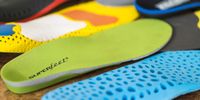Welcome to our guide to the best running insoles available today. Whether you're a competitive athlete, a casual jogger, or someone who loves to run for pleasure, finding the right pair of insoles can make a significant difference in your running experience. In this guide, we'll help you narrow down your choices and find the best insoles for your specific needs, whether you're dealing with flat feet, overpronation, or high arches.
Are Running Insoles Important?
Running insoles are designed to provide additional cushioning and support between your feet and the ground, which can help improve your running form, reduce the risk of injury, and alleviate foot pain. Over time, regularly using running insoles can help prevent foot injuries and conditions such as plantar fasciitis, Achilles tendinitis, and Shin splints. They can also offer support to running shoes, potentially preventing conditions like overpronation or flat feet from worsening or occurring in the first place.
How to Choose the Best Running Insoles:
When choosing running insoles, there are several factors to consider:
-
Arch Profile: Choose insoles designed for your specific arch profile and gait. Flat feet may require firm arch support, while high arches may require a deeper heel cup. Neutral runners can opt for support and cushioning, while underpronators may benefit from a lower-volume insole.
-
Level of Stiffness and Rigidity Versus Flexibility: High arches that remain fixed and move very little when standing may benefit from sturdier, more rigid insoles. Conversely, flexible arches that flatten when standing may require a more flexible insole.
-
Insole Volume: Look for insoles that match the volume of your running shoes. High-volume insoles can accommodate a wide range of arches but may not provide the same support they offer to underpronators.
-
Price: Insoles can range from basic footbed replacements to specialized insoles for specific conditions. Consider your budget and look for a pair that offers the right balance between support, comfort, and longevity.
-
Durability: Insoles should last at least as long as your running shoes, but examining them for visible wear will help you determine when it's time to replace them.
-
Custom orthotics: For runners with complex foot shapes or injuries, custom orthotics may provide the best support. These can be fabricated by a podiatrist and tailored to your specific needs.
What to Look for When Buying Running Insoles:
-
Support: Choose insoles that counteract the impact of running on your feet and joints by providing appropriate support for your arch type and ensuring durability. Look for insoles with a firm but adaptable platform.
-
Cushioning: Opt for insoles with plenty of soft cushioning to alleviate impacts and provide comfort. However, ensure they don't compromise support while still feeling responsive underfoot.
-
Fit: Make sure the insoles fit well and are easy to trim, particularly if you wear a wide or odd-sized foot. Look for options that are designed to adapt to different sizes or are easy to cut to size.
-
Materials: Some insoles, like solePerformance mediums, can be heat-molded to conform to your feet, while others are made from breathable materials. Consider your personal preferences and if you have allergies to certain materials.
-
Arch Support Level: Different arch designs offer varying levels of support. Look for insoles with the right amount of support, whether you're dealing with flat feet, overpronation, or overpronation.
-
Price: Insoles can range from affordable options to more specialized investments. Consider your budget and read reviews to determine if a pair will meet your needs and provide the right amount of support.
FAQs About Running Insoles:
Q: Do running insoles make me run faster?
A: Insoles can improve comfort and efficiency, which may lead to improved long runs, but they don't directly increase speed. They can help prevent injuries and alleviate foot pain while running.
Q: Can I wear running insoles if I have wide feet?
A: Absolutely, wide-toe boxes or non-standard size insoles are designed to accommodate wide feet and provide all the protection and comfort they need, regardless of the insole shape.
Q: Are there any brands I should try?
A: While there are many brands available, the most popular running insoles, such as Superfeet Run CUSHIONED or Dr. Scholl's orthotics, are widely used and tested by many runners.
Q: Do I need to break in running insoles?
A: While some insoles feel firm or uncomfortable at first, it's important to allow yourself a period of time to break them in by wearing them for short periods and increasing gradually. Most manufacturers suggest wearing your insoles for one to two hours for the first few days and increasing by an hour or two subsequent weeks.
Q: What is the shelf life of running insoles?
A: Typically, running insoles should last for several months, but it will depend on the amount of wear and tear the insoles receive. As with shoes, if you notice wear, damage, or changes in odor, it may be time to更换新的内底。
We hope this guide has helped you find the best running insoles for your needs, whether you're a competitive athlete, a casual jogger, or someone who enjoys the sport for pleasure. Before making a final decision, please consult a podiatrist or a professional running store to ensure that you are wearing the right insoles for your feet and running style.






